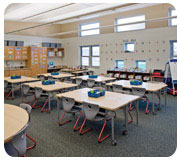
And “M” is for “More than one way to get the job done.” In this two-school tour, we start with an underfloor ventilation design and geothermal energy center in action. Then we take notes at a school with displacement ventilation, radiant floor heating, and radiant ceiling cooling. Round out the lesson with discussion of ASHRAE 62.1-2007 guidelines and the Wells-Riley equation for infection and ventilation, and your next school project is practically getting smarter already.
Areview of recent media coverage on airborne diseases such as H1N1 and various influenza strains indicates increased public awareness and sensitivity to the spread of such maladies. The classroom is an area where our children spend the greatest amount of time in close proximity to the highest number of potential infectors. Diseases are spread by a variety of means, such as surface deposition and skin contact, spray droplet transfer, airborne, etc. However, only the airborne portion falls directly under the control of HVAC design engineers, installing contractors, and facilities O&M staff. Recognizing this, how can we evaluate the ability of our systems to maintain appropriate IAQ?
ASHRAE Standard 62.1-2007 “Ventilation for Acceptable Indoor Air Quality”1 provides design and operation guidelines that generally falls into three categories:
- Sources of outside air (regional air quality, location of air intakes, etc.)
- Quantity of outside air (function of people count and building floor area)
- Delivery of outside air to the breathing zone (zone air distribution effectiveness)

Figure
1. A
radiant heating and cooling system with a DOAS was used at Georgetown
Elementary School, resulting in high IAQ and low energy consumption.
(Photo courtesy of GMB Architecture & Engineering.)
Indeed, even the U.S. Environmental Protection Agency (EPA)2 has weighed in on the concern of providing appropriate IAQ within classroom areas. The EPA has recommended consideration of central HVAC AHUs in lieu of some configurations of unitary, classroom-located HVAC units. These classroom-located units may not always provide consistent IAQ because their fans may be tuned for acoustics, they may be unable to provide higher levels of air filtration, and they have multiple outside air intakes and condensate drain pans that act as sources of contaminants, etc. A review of recently constructed educational facilities appears to indicate that the design team and the building owner increasingly consider these issues; however, it is still very possible to apply unitary equipment in a manner that can address these concerns.
If we consider the application of ASHRAE Standard 62.1-2007 in the design of an outside air delivery system, we see the ventilation quantity requirement being driven by multiple components: the number of occupants, the floor area of the zone, and the HVAC system’s effectiveness at delivering this outside air to the breathing zone of the occupants. Consider this example: a 1,000-sq-ft classroom of 34 students aged 9-plus years and an educator (total of 35 people). Table 6.1 within the Standard indicates an outdoor air rate of 10 cfm/person and an area outdoor air rate of 0.12 cfm/sq ft of the zone. Thus we need to deliver the following volume to the breathing zone of that classroom:
35 people x 10 cfm/person + 1,000 sq ft x 0.12 cfm/sq ft = 470 cfm
Having established this air volume requirement, we need to consider how effectively we can deliver this air to the breathing zone. Table 6.2 in the Standard defines zone air distribution effectiveness. (Ez) indicates this effectiveness can vary from 0.5 to 1.2, depending on the location of the air supply and return and the relative difference between the supply air temperature and the room air temperature. If we apply the two extremes in ventilation effectiveness from Table 6.2, we see a significant variance in the amount of outside air that we need to condition and deliver to the zone:
If the Ez is 0.5, our outside air requirement is 470 cfm / 0.5 = 940 cfm.
If the Ez is 1.2, our outside air requirement is 470 cfm / 1.2 = 392 cfm.
This yields quite a variation in air volume requirements, which will translate to significant differences in the capacity and first cost of the HVAC system and its related energy consumption. Ideally, we should focus on system configurations that provide Ez values as high as possible, typically 1.0 or better for systems that are commonly applied in educational facilities.
Applying the Wells-Riley Equation3 provides an interesting backdrop as we consider the spread of airborne diseases. This equation, developed in the 1940s, provides an estimated rate of infection as a function of the rate at which infectious material is discharged into the space, exposure time, air movement (dilution), outside air quantity (dilution/removal), and effectiveness of return air filters at capturing infectious materials (removal). This equation has some challenges as it is based on a fully mixed indoor air environment, and its application on system configurations that may employ stratification (such as displacement ventilation [DV]) is probably not accurate.
Additional research is needed on the ability of DV systems to capture and remove warm infectious materials expelled via breathing. European studies have shown lower concentrations of particles in the breathing zone when DV systems have been applied, but there is some speculation in the industry with regard to the system’s ability to adequately remove these airborne contaminants, since these systems rely on natural convection to transport these warm materials upwards where they are removed from the space.
If we design HVAC systems following ASHRAE Standard 62.1-2007 and adjust the outside air quantities to reflect Ez, we will see that the Wells-Riley Equation predicts virtually the same rate of disease spread for all systems. If we keep the overall volume of outside air constant between systems, we will see projected reductions in infection rates associated with HVAC systems that:
- Have higher Ez (including some overhead systems, most underfloor air distribution (UFAD) systems and DV systems)
- Have higher ability to remove contaminants via exhaust (dedicated outside air systems [DOAS] with 100% outside air and recirculating systems that have better filters or the ability to kill the infectious materials)
- Have higher air turnover rates that dilute the infectious material by mixing it with more air
However, the attendance rate information lacks granularity, in that we are unable to categorize the cause for the school absences into illness, family vacations, etc. Based on this broad experience, we have adopted an approach of applying systems with high ventilation effectiveness and DOAS with 100% outside air that is not recirculated between classrooms. Two examples follow.

Figure
2. Air
temperature uniformity at the radiant floor. (Figure courtesy of GMB
Architecture & Engineering.)
Quincy Elementary School
This was one of our first projects to employ a central geothermal energy center, which in this case includes five Waterfurnace 30-ton water-to-water heat pumps providing 45°F chilled water for cooling and 120° hot water for heating. A vertical closed-loop earth heat exchanger provides the heat source and sinks for the building. A single, dual-wheel, passive desiccant energy recovery unit from SEMCO Pinnacle functions as a DOAS unit and provides 62° to 65° supply air to each classroom. Each classroom then has a UFAD plenum with a hot water reheat coil to temper the supply air. The supply air is then distributed into the classroom via multiple VAV floor terminals from JCI/York FlexSys. Non-classroom spaces have dedicated water-to-air geothermal heat pumps.The UFAD system with a raised access floor over a concrete slab offers unique opportunities for using thermal mass as a flywheel to reduce peak load demands on the geothermal heat pump system. During the heating season, the DOAS operates during unoccupied periods in a recirculation mode (no outside air) and reduced air volume (approximately 30% of typical design) while the reheat coils at the raised floor plenums maintain a plenum (not space) temperature of 68° to 70°. Conversely, in the cooling season, the DOAS unit can operate at night to precool the concrete slabs in the classrooms to 70° to 72°.
The HVAC system is extremely quiet, providing classroom acoustical readings well under NC-30. This facility provides many of the benefits of a geothermal heat pump system with centralized HVAC equipment to simplify maintenance, reducing the number of condensate drain pans and eliminating moving parts in the classrooms other than the hot water reheat control valves and the underfloor air VAV terminals. The facility uses less than half the state average for energy consumption for elementary schools, yet it is fully air conditioned including even the gym, cafeteria, and media center in addition to all of the classrooms. Probably fewer than 20% of the elementary schools in this state can make that claim.

Figure
3. Isothermal
temperature contours show uniformity within the room. (Figure
courtesy of GMB Architecture & Engineering.)
Georgetown Elementary School
This project builds upon the successful system concepts piloted in the above project and employs radiant heating and cooling with a DOAS - a system concept that we believe represents some of the best contemporary thinking with regard to high thermal comfort, high IAQ, low HVAC-related noise, and excellent energy performance.The central plant energy center is again based on water-to-water geothermal heat pump technology, provided by Trane.
However, in this application, we are applying chilled water in a 58° to 62° range, instead of the 45° in the project above, due to the application of suspended radiant cooling panels within the classrooms. This “warmer” chilled water allows us to use water directly from the geothermal vertical closed-loop earth heat exchanger without operating the heat pump compressors for a portion of the cooling season. When this water is too warm to use directly, the geothermal heat pumps can produce the 58° to 62° chilled water at very high energy-efficiency ratios.
Zone heating is supplied via PEX tubing embedded within the concrete slabs of the classrooms and fed with 100° to 110° hot water. Our experience with radiant floor heating in educational facilities over the past two decades has shown us that this system can provide very high comfort levels with lower energy consumption when properly designed and operated.
Displacement ventilation is provided from a single DOAS system, from SEMCO Pinnacle, similar to the project above. In lieu of the 45° chilled water coil we have applied a water cooled DX refrigeration unit, from MultiStack, coupled with the geothermal heat pump loop to provide the cooler coil temperatures needed to maintain the supply air moisture at approximately 48 grains during the cooling months. This unique application employing the desiccant wheel in the DOAS allows lower supply air dewpoint conditions than would typically be possible at the design cooling coil temperatures. No issues with condensation on the radiant cooling panels have arisen, even during periods of Michigan high relative humidity weather.
The supply air is distributed to the classrooms via a concrete tunnel below the building slab. Careful attention was paid to the design and construction of this duct to reduce the potential for moisture to enter the air distribution path and an anti-microbial coating was applied to the concrete. The air enters the classrooms via displacement ventilation diffusers, from Price, designed to be encased within the classroom casework or to be wall mounted.
Extensive computational fluid dynamic (CFD) modeling was used during the design process to determine if the ventilation air traveling across the warmed floor slab in the heating mode would effectively reach a student in the far corner of the room. DV uses low velocity air (typically 40 fpm or less at the diffuser) that is slightly below the room temperature setpoint. This cooler air then flows across the floor (similar to water filling a bathtub), and the convective plumes associated with body heat pulls the ventilation air up through the breathing zone.
While in the breathing zone, the air conveys the warm contaminants from the occupants upward towards the ceiling where they are captured and exhausted from the building. No air is recirculated within the classroom or between the classrooms. Instead, 100% outside air, which is filtered and conditioned, provides a fresh indoor air environment. A recent visitor to the building was inquiring about the DV system, and the receptionist asked if he was there to visit their “new air building.” He asked her what she meant by that statement, and she indicated that her own children typically had several colds during the winter months in their previous school, but the frequency of their colds diminished significantly since they began attending here, which she attributed to the “new air” brought into each classroom.
Conclusion
As an industry, we have a significant responsibility to provide healthy, comfortable indoor environments for our students and their educators. We are challenged to share our experiences with our colleagues so that all of us can benefit from hearing of what works and what doesn’t. Hopefully some of what we have shared in this brief summary will spark a thought or inspire a system concept that will benefit all of us, and especially those that occupy the spaces that we design, build and operate.ESCited Works:
1. ANSI/ASHRAE Standard 62.1-2007 “Ventilation for Acceptable Indoor Air Quality.”2. Environmental Protection Agency/EPA Indoor Air Quality website; http://www.epa.gov/iaq/schooldesign/hvac.html#Selection of HVAC Equipment.
3. Wheeler, Arthur E., “Better Filtration for Healthier Buildings” ASHRAE Journal, June 1994.


